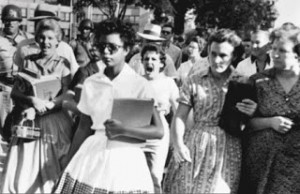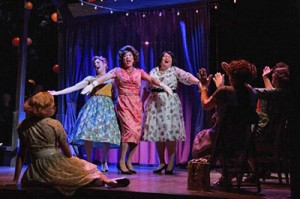 Louis Armstrong rarely spoke out in public about civil rights, or any other political matter. In September of 1957, though, he denounced the racial situation in Little Rock, where Orval Faubus, the governor of Arkansas, had ordered the National Guard to surround Central High School in order to prevent nine black children from enrolling there. Even when the guardsmen were joined by a threatening mob of white segregationists, President Eisenhower initially refused to take action to enforce Brown v. Board of Education, the 1954 Supreme Court decision ordering the desegregation of the public schools.
Louis Armstrong rarely spoke out in public about civil rights, or any other political matter. In September of 1957, though, he denounced the racial situation in Little Rock, where Orval Faubus, the governor of Arkansas, had ordered the National Guard to surround Central High School in order to prevent nine black children from enrolling there. Even when the guardsmen were joined by a threatening mob of white segregationists, President Eisenhower initially refused to take action to enforce Brown v. Board of Education, the 1954 Supreme Court decision ordering the desegregation of the public schools.
Armstrong was playing at the time in Grand Forks, North Dakota. Three days after Eisenhower met with Faubus, the trumpeter was interviewed there by Larry Lubenow, a local journalism student and part-time newspaper reporter. Lubenow asked him about Little Rock, and promptly wrote up Armstrong’s blunt, outspoken response for the Grand Forks Herald. His story was picked up by the Associated Press and appeared in newspapers all over the world:
Trumpet player Louis Armstrong said last night he had given up plans for a Government-sponsored trip to the Soviet Union because “the way they are treating my people in the South, the Government can go to hell.”
Here for a concert, Mr. Armstrong said President Eisenhower had “no guts” and described Gov. Orval E. Faubus of Arkansas as an “uneducated plow boy.”
He said the President was “two-faced” and had allowed Governor Faubus to run the Federal Government.
“It’s getting almost so bad a colored man hasn’t got any country,” the Negro entertainer said.
Armstrong’s statement, and the controversy that arose from it, makes for one of the most revealing episodes in a long and endlessly fascinating life. Accordingly, I described it in considerable detail in Pops: A Life of Louis Armstrong, my 2009 biography, drawing on a wide range of primary and secondary sources, and it later became the basis for one of the most widely remarked scenes in Satchmo at the Waldorf, my one-man play about Armstrong and his life.
While I was working on Pops, an important new source became available: Larry Lubenow himself, who had long since left journalism and was living in Cedar Park, Texas. (He died there earlier this month.) David Margolick tracked him down in Texas and interviewed him, and on September 23, 2007, fifty years after Armstrong spoke out about Little Rock, Margolick published an op-ed piece in the New York Times called “The Day Louis Armstrong Made Noise” in which he retold the tale from Lubenow’s point of view, supplying previously unavailable details about the encounter. It was an amazing find, one of the most significant pieces of Armstrong-related research in the years since the trumpeter’s death.
 Because Margolick’s story was published in a family newspaper, he used a fairly transparent euphemism to describe the colorful language that Armstrong had actually used to describe Faubus and John Foster Dulles, Eisenhower’s secretary of state. (If you’ve read Pops or seen Satchmo at the Waldorf, you know what he really said.) Margolick had interviewed Lubenow a few days earlier in a public presentation sponsored by New York’s Louis Armstrong House Museum and Archive, so I got in touch with Michael Cogswell, who runs the museum, and asked him to put me directly in touch with Lubenow. Cogswell gave me Lubenow’s e-mail address, and I wrote to him to confirm, among other things, that Armstrong had in fact used the “double-barreled hyphenated expletive” (it was a favorite of his) that I assumed he had used. He wrote back to assure me that I’d guessed right.
Because Margolick’s story was published in a family newspaper, he used a fairly transparent euphemism to describe the colorful language that Armstrong had actually used to describe Faubus and John Foster Dulles, Eisenhower’s secretary of state. (If you’ve read Pops or seen Satchmo at the Waldorf, you know what he really said.) Margolick had interviewed Lubenow a few days earlier in a public presentation sponsored by New York’s Louis Armstrong House Museum and Archive, so I got in touch with Michael Cogswell, who runs the museum, and asked him to put me directly in touch with Lubenow. Cogswell gave me Lubenow’s e-mail address, and I wrote to him to confirm, among other things, that Armstrong had in fact used the “double-barreled hyphenated expletive” (it was a favorite of his) that I assumed he had used. He wrote back to assure me that I’d guessed right.
After consulting the tape of the Lubenow-Margolick interview, I incorporated what I’d learned into my account of what happened in 1957. Since the public interview and my own e-mail exchange with Lubenow were the primary sources for this part of my account, I summarized what I’d done as follows in my first source note:
A journalism student: Larry Lubenow, personal communication. Lubenow spoke for the first time in public about his interview with LA [i.e., Louis Armstrong] on Sept. 18, 2007, in a presentation sponsored by AA [i.e., the Louis Armstrong House Museum and Archive]. This account is based in part on the presentation.
I then cited in later notes the many contemporary newspaper accounts on which I also drew.
What is missing from this source note? David Margolick’s name, of course. Failing to mention him was an unintentional and innocent oversight, but I realize in retrospect that I should have done so, since it was Margolick who found Larry Lubenow, obtained his version of the encounter, and made it part of the historical record, subsequently incorporating the story into an important 2011 book about the Little Rock crisis called Elizabeth and Hazel: Two Women of Little Rock.
My mistake was, to be sure, a tiny one, but an important one, enough so that Margolick got in touch with me and with Houghton Mifflin Harcourt, the publishers of Pops, asking that it be rectified. We agreed to change the source note in the second printing of the paperback edition of Pops.
Alas, there hasn’t been one yet—the first printing has yet to sell out—and so the mistake remains unfixed. Margolick now thinks that we shouldn’t wait until the second printing, which is scheduled to take place some time next year, to correct my error. I agree.
I trust that nobody who read Pops in 2009 assumed that I was the person who originally tracked down Larry Lubenow. In fact, every Louis Armstrong scholar in the world was already well aware of Margolick’s discovery, since he published it on the op-ed page of the New York Times, which is widely circulated, two years before Pops came out. But I wouldn’t want anyone to suppose that I’d been trying to claim retrospective credit for what he did, and I deeply regret any impression to the contrary that may have been made by my original source note.
If you’re not a scholar, this may seem like a great deal of fuss to make over a couple of missing words in a footnote. But when it comes to the historical record, such words, as Mark Twain famously put it, sometimes constitute “the difference between the lightning-bug and the lightning.” Since its publication five years ago, Pops has been widely accepted as the standard biography of Louis Armstrong. I’m proud of that achievement, and it’s important to me to ensure that everyone who helped make it possible receives proper credit. Chapter 11 of Pops wouldn’t have been the same without David Margolick. I sincerely apologize for having neglected to specifically credit him by name in my source notes, and I can assure him—and you—that all future printings of Pops will do so.



